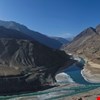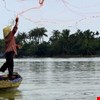
Karachi was characterised by inadequate water and sanitation services and wasteful and injudicious use of water by consumers. To address these issues, the Karachi Water Partnership was formed as a platform for collective action by all concerned stakeholders to better manage water resources through IWRM. The experience illustrates that there can be great value in simply improving the existing delivery mechanisms as a compliment to the implementation of new ideas.

The Indus River is a major transboundary river in Asia with nine tributaries. The River is about 2,800km long, with 2,682 km in Pakistan. The Indus drainage basin covers an area of about 1,140,000 km2 stretching from Afghanistan through China, India, and Pakistan. Monsoonal rains are the most important flood-causing factor in the Indus basin, followed by the size, shape, and land-use of the catchments as well as the conveyance capacity of the corresponding streams. The monsoon rains fall from June to September, and are generally intense and widespread.

Decades of underinvestment led to poor water and wastewater services and low coverage in Manila. Due to this poor service, the government was unable to increase its water tariffs due to customers’ unwillingness to pay. This situation translated into very low cash flows for the government, thus leading again to the issue of underinvestment, which soon turned to a vicious cycle.

Water is needed for drinking and irrigation purposes and paradoxically, in Bhutan water shortages occur despite the presence of sufficient resources. In order to provide irrigation water to farmers living in upper slopes and hilltops in Lingmutey-chu who faced issues in accessing water in 2014, a siphon project was initiated by GWP Bhutan/Royal Society for Protection of Nature in collaboration with the Ministry of Agriculture and Forest in Bhutan.

Due to temporal and spatial variability of rainfalls, Sri Lanka experience local scarcity. Furthermore, most water resources are used for irrigation, and little is left for industry and domestic use. Action was taken towards policy reform but these reforms were, however, nationally desired but externally designed, leading to failure since they did not account for the Sri Lankan context. This case study thus illustrates the crucial importance of national anchoring of policies.

The most pressing problem facing the Songkhla Lake Basin is land degradation and water pollution caused by land use changes and shrimp farming expansion. Action was taken to combat these issues and an Integrated Environmental Management approach was applied. The key lesson of this case is that replacing blueprint master planning approaches with process oriented planning frameworks increased sustainability significantly.

For the past century, Thailand had been experiencing constant severe floods which typically occurred in between August and December. Yet, the worst flood ever experienced in more than a half century in Thailand was the mega 2011 flood – indicating tremendous loss of lives and properties across socio-economic sectors.
The Mekong is the longest river in Southeast Asia, beginning its 4,200 km journey in the mountains of the Tibetan Plateau, passing six countries and reaching the South China Sea. Policy reforms to adopt integrated water resources management had been initiated and water related laws had been developed. However, there were still major gaps in the supporting knowledge and information. IUCN and its program Water &Nature Initiative (WANI) supported to scale up so called Tai Baan research (villagers’ research) that enabled local communities to represent their own social reality and through media and public forum, this knowledge can be mainstreamed into water management research and implementation.

There are growing concerns about the potential effects of climate change on the socio-economic characteristics and natural resources of the Lower Mekong Basin. In response to the potential impacts of climate change, the Mekong River Commission has launched the regional Climate Change and Adaptation Initiative. Furthermore, a Vulnerability and Adaptation Assessment has been conducted. The most important lesson learnt is that it is essential to establish a regional organisation to combat climate change.

Steadily shrinking for decades due to unsustainable irrigation policies, the Aral Sea is under increasing pressure, making both allocation and availability major challenges. Action has been taken and the Basin Economic Allocation Model has been developed as a long-term decision support system to facilitate putting “value on water use”. This demonstrates that economic models can be applied to assess economic value maximization of different water uses.